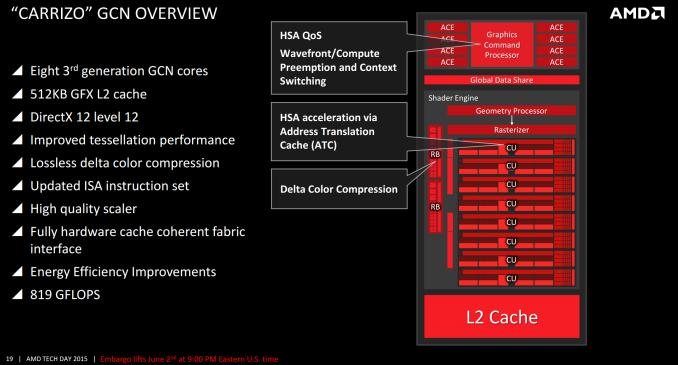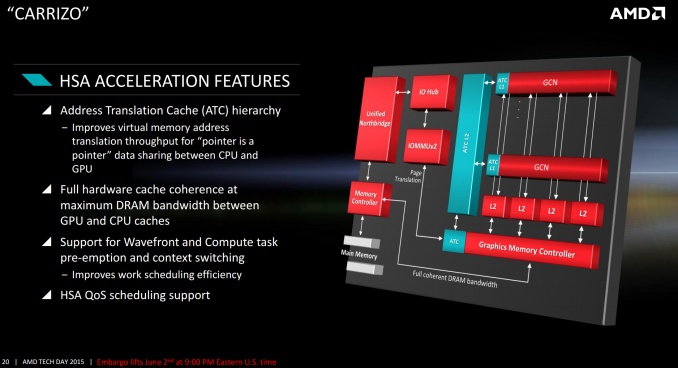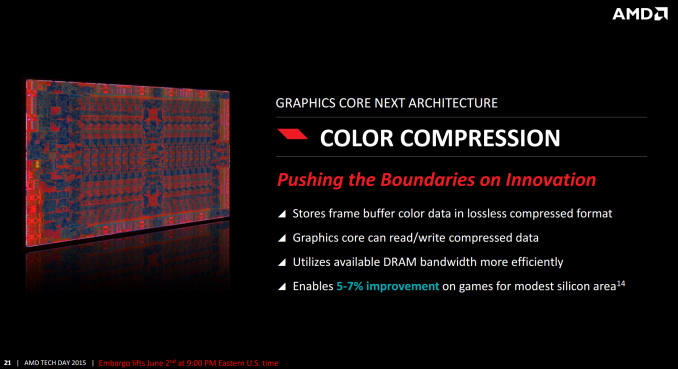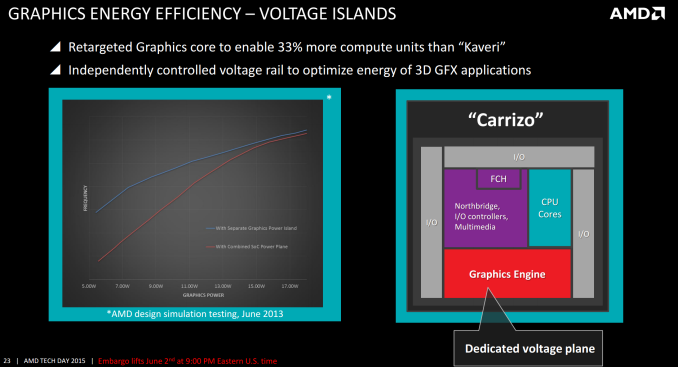AMD Launches Carrizo: The Laptop Leap of Efficiency and Architecture Updates
by Ian Cutress on June 2, 2015 9:00 PM ESTGraphics
The big upgrade in graphics for Carrizo is that the maximum number of compute units for a 15W mobile APU moves up from six (384 SPs) to eight (512 SPs), affording a 33% potential improvement. This means that the high end A10 Carrizo mobile APUs will align with the A10 Kaveri desktop APUs, although the desktop APUs will use 6x the power. Carrizo also moves to AMD’s third generation of Graphics Core Next, meaning GCN 1.2 and similar to Tonga based retail graphics cards (the R9 285).
This gives DirectX 12 support, but one of AMD’s aims with Carrizo is full HSA 1.0 support. Earlier this year when AMD first released proper Carrizo details, we were told that Carrizo will support the full HSA 1.0 draft as it currently stands as it has not been ratified, and they will not push back the launch of Carrizo until that happens. So there is a chance that Carrizo will not be certified has a fully HSA 1.0 compliant APU, but very few people are predicting major changes to the specification at this point before ratification that requires hardware adjustments.
The difference between Kaveri’s ‘HSA Ready’ and Carrizo’s ‘HSA Final’ nomenclature comes down to one main feature – context switching. Kaveri can do everything Carrizo can do, apart from this. Context switching allows the HSA device to switch between work asynchronously while it waits on the other part that needs to finish. I would imagine that if Kaveri came across work that required this, it would sit there idle waiting for work to finish before continuing, which means that Carrizo would be faster in this regard.
One of the key parts of HSA is pointer translation, allowing both the CPU and GPU to access the same memory despite their different interpretations of how the memory in the system is configured. One of the features on Carrizo will be the use of address translation caches inside the GPU, essentially keeping a record of which address points to which data and when an address is in a lower cache, that data can be accessed quicker. These ATC L1/L2 caches will be inside the compute units themselves as well as the GPU memory controller and an overriding ATC L2 beyond the regular L2 per compute unit.
Use of GCN 1.2 means that AMD can use their latest color compression algorithms with little effort – it takes a little more die area to implement (of which Excavator has more to play with than Kaveri), but affords performance improvements particularly in gaming. The texture data is stored losslessly to maintain visual fidelity, and move between graphics cores in this compressed state.
In yet more effort to suction power out of the system, the GPU will have its own dedicated voltage plane as part of the system, rather than a separate voltage island requiring its own power delivery mechanism as before. AMD’s latest numbers on the improvements here only date back to June 2013 via internal simulations, rather than an actual direct comparison.
All the performance metrics rolled in, and AMD is quoting a 65% performance improvement at 15W compared to Kaveri. The adjustment in design is allowing higher frequency for the same power, combined with the additional compute units and other enhancements for the overall score. At 35W the gain is less pronounced, but more akin to regular generational improvements anyway. What we see at 35W is what we would normally expect, and it pales in comparison to the 15W numbers.















137 Comments
View All Comments
yankeeDDL - Wednesday, June 3, 2015 - link
If you think as gaming as hard-core gaming, latest and greatest titles, max settings, high res, then yes, I agree.But, as a father, I can tell you that there are tons of kids that are OK with "some" gaming and for whom the parents won't fork 1Kusd for a powerful gaming rig, and for which AMD really offers a price/performance ratio that cannot be compared.
FlushedBubblyJock - Tuesday, June 9, 2015 - link
having kids in usa is down down down, so not so much biz therebarleyguy - Thursday, June 4, 2015 - link
The marketing for this particular launch is specifically targeting players of MOBAs, such as League of Legends, DOTA2, and Starcraft. The active players of those 3 games is about 100 million people. You can argue that's not a majority of users, but AMD has never had a majority share of laptops, and 100 million people is a sizable market.I expect that AMD will make more direct appeals for that group of people, such as sponsoring tournaments, and generally trying to establish mindshare for laptops in that group.
I don't think targeting that particular niche market is a bad idea, personally.
Refuge - Thursday, June 4, 2015 - link
Their APU's can perform on those games very well, but also so can all of Intel's HD series graphics, at least every rendition I've ever seen.It won't be an easy crowd to win over. Even if the requirements for their sport only warrant a $300 computer, you know they are gamers and still want their supercomputers.
Magichands8 - Wednesday, June 3, 2015 - link
I agree with this. But it also doesn't make sense to me why they have. CPU's have been commodity devices for some time now and it makes no sense to me whatsoever that the average consumer would buy Intel when they can transparently get the very same performance for their needs with a much cheaper AMD processor. This, plus the fact that AMD does so well with essentially embedded systems (XBox, Playstation) even though they are 'AMD Inside' suggests to me that their struggle is largely due to marketing failures rather than technological ones.medi03 - Thursday, June 4, 2015 - link
Athlon 64th were outsold by Intel's Prescott that was:a) slower
b) consumed more power
c) more expensive
also because of "AMD's marketing failures" I guess...
FlushedBubblyJock - Tuesday, June 9, 2015 - link
no it's the skin that surrounds the amd heart - and that skin is cheap and ugly - that's how amd plays their cards... a low class dirt bucket cheap compile - so even if it could be made to look great and "feel very expensive and well constructed" - those creating AMD skin WON'T DO IT.FlushedBubblyJock - Tuesday, June 9, 2015 - link
Thinking again I will admit when browsing new laptops in person AMD GAMING ! is not something I can ever recall seeing ... it's very tough sometimes just to get the basic specs visible by the box stores....AS118 - Wednesday, June 3, 2015 - link
I don't ind 1366 x 768 on a smaller screen (14" and less for me) and think that AMD's performance on 900p and below's great. I also think that it's sad that more people don't know about them and how capable they are.Many casual customers who would want that extra gaming performance don't even know it exists on A8's and A10's.
AS118 - Saturday, June 6, 2015 - link
Yeah, I don't mind 1366 x 768 myself on smaller laptops, and gaming at that resolution is a thing with AMD APU's. Gaming performance on the A8 and especially A10 APU's is why I've been getting AMD Processors on Laptops for years.I don't need a lot of GPU oomph on my laptops, just needed the option to play casual games and not that hard to run stuff like WoW (well, before WoD at least) on the go.